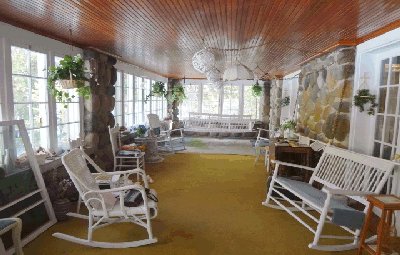"The Genschaw Place," as it's referred to by the locals, is a grand residence built in 1940 with three master suites on the main floor, each with original imported Italian marble baths, and a servants' quarters above the garage. You can find more pictures on our website here. (The home sold this summer.)
 |
| Enclosed porch of the "Genshaw House" |
 |
| The Lee Plaza |
By 1930, when Eugenie was 20 years old, she was a young divorcee living with her parents in their lavish Detroit flat and spending time at the family's summer estate on Presque Isle Harbor. That summer, Ross W. Judson, founder of the Continental Motor Company, parked his $750,000 mega-yacht in Presque Isle Harbor and hosted a party, which Eugenie attended.
 |
| One of Judson's yachts, the Trudione, built in 1930 |
 |
| Interior of the COMOCO, another of Judson's yachts |
The following year, seemingly out of nowhere, Eugenie's attorney filed an intent to place a $250,000 suit against Mr. Judson, to his disbelief. He could not imagine what he could have done to provoke Miss Salmon. (Mr. Judson, inventor of the 4 cylinder engine, had initially invested $2,800 into his company in 1903 and upon his retirement in 1929 was reportedly worth $35,000,000 - about $480,000,000 today.) With her attorney keeping mum about the nature of the charges, many speculated a scandalous affair between the millionaire yachtsman and the dark, dashing young divorcee.
 |
| Eugenie Salmon & Ross W. Judson |
As more details of the suit emerged, the charges were revealed. Eugenie alleged that while she was in Judson's dinghy headed for his yacht moored in Presque Isle Harbor, she was thrown back in the boat and hurt her spine, which had affected her nerves. She claimed that this injury had ruined her chances of a career in show business, and wanted $250,000 in compensation.
The suit was eventually thrown out, with Eugenie being paid a very small sum of money to cover her medical expenses. She was quoted as saying the whole ordeal was "just business" and that Judson should not take it personally.
In 1931, Eugenie wandered into the Radio-Electrical World's Fair in Chicago, and her striking beauty earned her the title of "Miss Television," a title for which dozens of girls were competing. She was possibly not even aware of the contest before arriving.
In 1934, Eugenie married a wealthy older stockbrocker from New York City named Alfred Stamm.
 |
| Alfred Stamm |
Soon thereafter, construction began on a lavish summer residence on Lotus Pond in Presque Isle, which took 2 full years to finish. The home contained 5 bedrooms, each with its own bath featuring imported Italian marble, a maid's quarters, and even a bomb shelter build under the grand full-length porch facing Lotus Pond. The home was finished in 1940.
 | ||
| One of the Italian marble tile baths |
After she finished buying everything she could possibly find for herself, she began shipping the items, along with everything else the couple already owned, to warehouses, to family, and to the Lotus Pond house. Before long, both the couple's secondary flats at the Eldorado and the Carlyle were completely cleaned out, down to the carpets, the ashtrays, and the kitchen utensils, unbeknownst to her busy husband.
Then one summer day, while at the Lotus Pond house, Alfred was shocked when Eugenie spoke these words seemingly out of the blue - "I am through with you." When he asked what was wrong she simply replied, "Go back to New York. You'll find out." She was, of course, referring to the fact that he would return to apartments that were completely stripped bare of everything but his own clothing. She then added that if her parents were to force her to return to New York with him, she would show him how to spend money. She'd keep spending until he was begging her for a divorce. Her parents did not, fortunately for Alfred, suggest that she save her marriage with him.
Eventually, Alfred sued Eugenie for her crimes against him. She asserted that he had urged her to stock up on necessities with wartime shortages and price hikes on the horizon. She claimed that he hit the children with a long stick at the dinner table if they misbehaved, and that she had become a nervous wreck because of his treatment of the family. He countered that she was so obsessed with trimming down to return to a life in show business, that her extreme dieting, consuming of various weight loss substances, and her stress over her body were to blame for her nervous condition.
The case was the first to raise the question, "Who's money is it? HIS or THEIRS?" The case was used as support for countless others in which wives spent their husbands money without the husband's consent. When it came time for a divorce, Eugenie refused, not wanting to give up the large allowance of money she was currently receiving in their separation. Eventually, in 1944, Alfred found a court in Florida which agreed to grant the divorce without Eugenie's consent. The Lotus Pond home was sold as a part of the divorce proceedings.




No comments:
Post a Comment